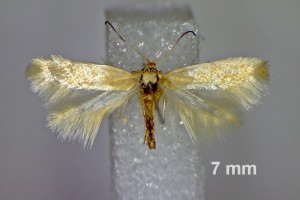

 +1Kontinente:EU
+1Kontinente:EU2. Diagnose
2.1. Männchen
3. Biologie
3.1. Nahrung der Raupe
- [Fabaceae:] Cytisus decumbens [= Corothamnus decumbens, Genista decumbens] (Niederliegender Geißklee, Liegend-Geißklee, Östlicher Besen-Geißklee)
Die Raupen sind extrem schwer zu finden, da sie keine äußerlich gut sichtbaren Spuren an ihren Pflanzen hinterlassen. Laštůvka & Laštůvka (2005: 9) können mitteilen: "Biology and habitat (fig. 20). The larva develops in the stem of Corothamnus decumbens (Durande) Spach. It does not mine but lives inside the stem where it makes a spiral gallery around the pith. Usually the gallery is not visible on the stem from outside and therefore the larvae are very difficult to find. A small and indistinct gall develops in several cases only if the larva leaves the stem (and/or the stem dries up). The species was found on river alluvials and on southern or southwestern slopes on limestone with xerothermophilous or subxerothermophilous herbaceous and shrub communities".
4. Weitere Informationen
4.1. Etymologie (Namenserklärung)
Laštůvka & Laštůvka (2005: 9) schreiben: "Derivatio nominis. After the name of the type locality." Typenfundort ist Trasaghis in Italien.
4.2. Faunistik
Die Art wurde aus der Provinz Udine in Italien beschrieben und ist bisher auch nur vom italienischen Festland bekannt.
4.3. Typenmaterial
Laštůvka & Laštůvka (2005: 9) beschrieben die neue Art auf der Basis von 5 Faltern: "Holotype ♂, Italia sept., Udine, Trasaghis, 28.vi.2000, lgt. et coll. A. Laštůvka; Paratypes 3 ♂♂, 1 ♀: 1 ♂, same data; 1 ♂, same locality, but vi.2001 ex larva (larva 30.iv.2001); 1 ♀, same locality, but vi.2003 ex larva (larva 1.v.2003); 1 ♂, Italia, Friuli V. Giulia, Pordenone: San Quirino, 11.vi.2001, lgt. P. Huemer, coll. TLMF."
(Autor: Erwin Rennwald)
4.4. Literatur
- Erstbeschreibung: Laštůvka, A. & Z. Laštůvka (2005): Four new Trifurcula species and additional faunal data on Nepticulidae from Italy (Lepidoptera: Nepticulidae). — Acta universitatis agriculturae et silviculturae Mendelianae Brunensis 53 (1): 7-14 [PDF auf acta.mendelu.cz].




